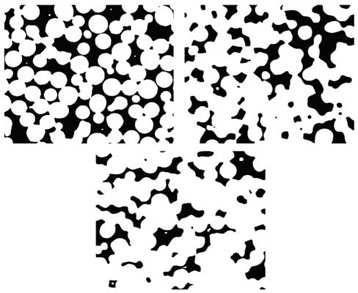Chapter 3
Random Sets for Texture Analysis 1
3.1. Introduction
Visually homogeneous images, suggesting the presence of a texture, are a common feature of many fields (e.g. in materials science, earth sciences, and life sciences). We would like to describe such textures quantitatively. To better understand the ideas at work, let us consider the three micro-structures in Figure 3.1, which show bronze balls that were sintered over two-hours at three different temperatures (730°C, 750°C, and 770°C). The question being posed is how to quantify the evolution of the porosity as a function of the sintering temperature.
Another, more elaborate, example is shown in Figure 3.2. It shows the micrography of a white cast-iron lamellate. We can perceive that the image is partitioned into regions within which the plates maintain the same orientation. This leads to a number of questions, such as: what are the dimensions of these regions? What is the law that defines the orientations of the plates in each region? Does a dependence exist between the size of the regions and the orientation of the plates? Do adjacent regions have similar plate orientations?
Figure 3.1. Evolution of porosity of sintered material as a function of temperature

With these kinds of problems, the practical difficulties that may be encountered are numerous. First of all, it is not at all guaranteed that the information being ...
Get Stochastic Geometry for Image Analysis now with the O’Reilly learning platform.
O’Reilly members experience books, live events, courses curated by job role, and more from O’Reilly and nearly 200 top publishers.

